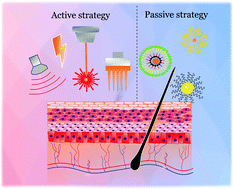当前位置:
X-MOL 学术
›
J. Mater. Chem. B
›
论文详情
Our official English website, www.x-mol.net, welcomes your feedback! (Note: you will need to create a separate account there.)
Nanomaterials for transdermal drug delivery: beyond the state of the art of liposomal structures
Journal of Materials Chemistry B ( IF 7 ) Pub Date : 2017-10-16 00:00:00 , DOI: 10.1039/c7tb02529g Roxana Jijie 1, 2, 3, 4, 5 , Alexandre Barras 1, 2, 3, 4, 5 , Rabah Boukherroub 1, 2, 3, 4, 5 , Sabine Szunerits 1, 2, 3, 4, 5
Journal of Materials Chemistry B ( IF 7 ) Pub Date : 2017-10-16 00:00:00 , DOI: 10.1039/c7tb02529g Roxana Jijie 1, 2, 3, 4, 5 , Alexandre Barras 1, 2, 3, 4, 5 , Rabah Boukherroub 1, 2, 3, 4, 5 , Sabine Szunerits 1, 2, 3, 4, 5
Affiliation

|
A wide range of biomedical materials have been proposed to meet the different needs for controlled oral or intravenous drug delivery. The advantages of oral delivery such as self-administration of a pre-determined drug dose at defined time intervals makes it the most convenient means for the delivery of small molecular drugs. It fails however to delivery therapeutic macromolecules due to rapid degradation in the stomach and size-limited transport across the epithelium. The primary mode of administration of macromolecules is presently via injection. This administration mode is not without limitations, as the invasive nature of injections elicits pain and decreases patients’ compliance. Alternative routes for drug delivery have been looked for, one being the skin. Delivery of drugs via the skin is based on the therapeutics penetrating the stratum corneum (SC) with the advantage of overcoming first-pass metabolism of drugs, to deliver drugs with a short-half-life time more easily and to eliminate frequent administrations to maintain constant drug delivery. The transdermal market still remains limited to a narrow range of drugs. The low permeability of the SC to water-soluble and macromolecular drugs poses significant challenges to transdermal administration via passive diffusion through the skin, as is the case for all topically administered drug formulations intended to bring the therapeutic into the general circulation. To widen the scope of drugs for transdermal delivery, new procedures to enhance skin permeation to hydrophilic drugs and macromolecules are under development. Next to the integration of skin enhancers into pharmaceutical formulations, nanoparticles based on lipid carriers have been widely considered and reviewed. While being briefly reviewed here, the main focus of this article is on current advancements using polymeric and metallic nanoparticles. Next to these passive technologies, the handful of active technologies for local and systemic transdermal drug delivery will be discussed and put into perspective. While passive approaches dominate the literature and the transdermal market, active delivery based on microneedles or iontophoresis approaches have shown great promise for transdermal drug delivery and have entered the market, in the last decade. This review gives an overall idea of the current activities in this field.
中文翻译:

用于透皮药物递送的纳米材料:超越脂质体结构的最新技术水平
已经提出了各种各样的生物医学材料来满足控制口服或静脉内药物递送的不同需求。口服给药的优点,例如在规定的时间间隔内自行给药预定的药物剂量,使其成为最方便的小分子药物给药方法。然而,由于胃中的快速降解和跨上皮细胞的大小受限的运输,它无法递送治疗性大分子。目前大分子的主要给药方式是通过注射。这种给药方式并非没有局限性,因为注射的侵入性会引起疼痛并降低患者的依从性。寻找药物的替代途径,一种是皮肤。通过以下方式递送药物皮肤基于穿透角质层(SC)的治疗剂,其优点是克服了药物的首过代谢,可以更轻松地以短生命期传递药物,并且消除了频繁给药以维持恒定药物传递的方式。透皮市场仍然局限于有限范围的药物。SC对水溶性药物和大分子药物的低渗透性给通过皮肤的透皮给药带来了重大挑战通过皮肤的被动扩散,就像所有旨在将治疗剂引入全身循环的局部给药药物配方一样。为了扩大用于透皮递送的药物的范围,正在开发新的程序以增强皮肤对亲水性药物和大分子的渗透。除了将皮肤增强剂整合到药物制剂中以外,基于脂质载体的纳米颗粒已被广泛考虑和审查。在这里进行简要回顾时,本文的主要重点是使用聚合物和金属纳米粒子的最新进展。除了这些被动技术之外,还将讨论并介绍一些用于局部和全身透皮给药的主动技术。尽管被动式方法在文献和透皮市场上占主导地位,在过去的十年中,基于微针或离子电渗疗法的主动递送已显示出透皮药物递送的巨大前景,并已进入市场。这篇综述给出了该领域当前活动的总体思路。
更新日期:2017-11-15
中文翻译:

用于透皮药物递送的纳米材料:超越脂质体结构的最新技术水平
已经提出了各种各样的生物医学材料来满足控制口服或静脉内药物递送的不同需求。口服给药的优点,例如在规定的时间间隔内自行给药预定的药物剂量,使其成为最方便的小分子药物给药方法。然而,由于胃中的快速降解和跨上皮细胞的大小受限的运输,它无法递送治疗性大分子。目前大分子的主要给药方式是通过注射。这种给药方式并非没有局限性,因为注射的侵入性会引起疼痛并降低患者的依从性。寻找药物的替代途径,一种是皮肤。通过以下方式递送药物皮肤基于穿透角质层(SC)的治疗剂,其优点是克服了药物的首过代谢,可以更轻松地以短生命期传递药物,并且消除了频繁给药以维持恒定药物传递的方式。透皮市场仍然局限于有限范围的药物。SC对水溶性药物和大分子药物的低渗透性给通过皮肤的透皮给药带来了重大挑战通过皮肤的被动扩散,就像所有旨在将治疗剂引入全身循环的局部给药药物配方一样。为了扩大用于透皮递送的药物的范围,正在开发新的程序以增强皮肤对亲水性药物和大分子的渗透。除了将皮肤增强剂整合到药物制剂中以外,基于脂质载体的纳米颗粒已被广泛考虑和审查。在这里进行简要回顾时,本文的主要重点是使用聚合物和金属纳米粒子的最新进展。除了这些被动技术之外,还将讨论并介绍一些用于局部和全身透皮给药的主动技术。尽管被动式方法在文献和透皮市场上占主导地位,在过去的十年中,基于微针或离子电渗疗法的主动递送已显示出透皮药物递送的巨大前景,并已进入市场。这篇综述给出了该领域当前活动的总体思路。



























 京公网安备 11010802027423号
京公网安备 11010802027423号